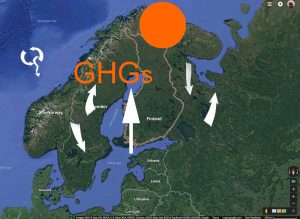But it is far from clear that Finland has figured it all out
 In a blistering op-ed a few days ago, somewhat contradicting opinions expressed earlier, Harold Alexander goes after the “steady stream of similarly negative articles and opinions in The Chronicle Herald about the biomass power plant at Port Hawkesbury Paper” and provides “another opinion that is based on facts rather than hearsay and innuendo”, citing his own experience and information gained on visits to Finland.
In a blistering op-ed a few days ago, somewhat contradicting opinions expressed earlier, Harold Alexander goes after the “steady stream of similarly negative articles and opinions in The Chronicle Herald about the biomass power plant at Port Hawkesbury Paper” and provides “another opinion that is based on facts rather than hearsay and innuendo”, citing his own experience and information gained on visits to Finland.
View COMMENTARY: In Finland, biomass is not a dirty word
by Harold Alexander in the Chronicle Herald, Mar 30, 2018
Alexander challenges three themes in “Mr. Beswick’s article”, referring I guess to Old-growth burning reignites biomass debate by Aaron Beswick in the Chronicle Herald, Mar 17, 2018. The themes (according to Mr. Alexander):
Theme No. 1: We are grinding up hardwood logs for biomass to supply the NSP plant at PHP, and hardwood flooringplants have closed because of it.
In brief, Alexander says “there are very few quality hardwood logs left growing in our forests”, we need to improve our forests and to do that we need a market for thinnings; also he asks “So, why is The Chronicle Herald and the ever-growing band of critics of the power plant at PHP not squawking about every firewood producer in Nova Scotia as well?”
Theme No. 2: “The NSP plant at PHP is way too big.”
Says Alexaneder “This plant is not too big and should be considered a valuable piece of our forest sector. In Finland, every single pulp, paper or paperboard mill has a similar co-generation (heat and electricity) facility attached to it, because the mill and the heating plant are a great match. The mill generates waste, mostly from bark that can be used by the heating plant to provide heat and electricity to the mill and the surrounding community as well, similar to the heating plant we visited in Kuopio.”
Theme No. 3: “They’re going to cut down all our forests, especially our Crown forests, to feed this monstrosity.”
Says Alexander: “This also isn’t true. We could sustainably harvest so much more wood in Nova Scotia annually if we put our minds and a little more effort into it…“
View also Lessons for Nova Scotia from private land forestry in Finland
Post Aug 7, 2017
On the surface of it, Mr. Alexander’s comments are reasoned. So are the voluminous documents that allow European forest biomass energy to be considered carbon neutral under international conventions – and Canada to be its No 2 supplier of woodchips.
Unfortunately, that doesn’t mean European forest biomass energy is carbon neutral, such is the science, politics and inevitable inertia when it comes to modifying international conventions.
We may wish for forest biomass to provide an alternative to the now mostly lost markets for pulp and paper, and as such it could perhaps fulfill all of the things Mr. Alexander talks about and I wish it could, but it’s becoming increasingly clear that will work climate-wise only on a small scale and only using genuine sawmill wastes.
Perhaps thinings are OK – the scientific jury seems to be still out on that – but the scientific evidence is only getting stronger that leftovers from clearcuts not processed into pulp and paper or lumber, and whole clearcuts going directly to biomass are far from carbon neutral when burned in large biomass facilities or in home heating systems or processed into biofuels and the like.

Depending on its source, even use of wood for home heating can increase GHG emissions. As a fuel, wood has a pollutant emissions profile similar to coal.
I suspect that a full carbon accounting would indicate there is some room for firewood for home heating at a traditional scale of use of in Nova Scotia; and perhaps even for a limited number of distributed smaller scale biomass heating units, but we need comprehensive, transparent forest carbon accounting to figure it all out, and if you look at some of the lit/links below, it’s clear that even with a lot of high level science and accounting, Finland has still not figured it out.
To complicate matters further for us all, the science of forest carbon accounting is still actively evolving. That’s just a reality to address on top of the consequences we are likely facing if we don’t drastically reduce carbon emissions globally by 2030.
There is a voluminous literature on these topics, which I will attempt to provide some insight to in my Nova Scotia forests, forestry and GHGs posts, but those will be slow coming. In the meantime, a few Links below provide some examples relevant to Finland.
As in Nova Scotia, there are also big concerns about impacts of forestry on biodiversity in Finnland:
According to a recent study 89 % of Finns thought that forest biodiversity is more important than the increase of logging. The recreational value of forests and their multiple social, ecological and economic benefits are thoroughly appreciated, but safeguarding them would require renewing forestry practices thoroughly. Source: The Finnish Association for Nature Conservation Policy Brief March 2017
LINKS
Balance missing from bioeconomy
The Finnish Association for Nature conservation, Jun 21, 2016. “The stance of the Finnish Government is that bioenergy should always be emissions neutral. Finland seeks to reach its renewable energy goals through the use of bioenergy, i.e. forest biomass. However, there are problems involved with the harvesting and burning of forest biomass: the capacity of forests to store carbon.”
A critical analysis of the carbon neutrality assumption in life cycle assessment of forest bioenergy systems
Weiguo Liu et al., 2018. Environmental Reviews 18: 93-101
‘This study presents a critical analysis regarding the assumption of carbon neutrality in life cycle assessment (LCA) models that assess climate change impacts of bioenergy usage. We identified a complex of problems in the carbon neutrality assumption, especially regarding bioenergy derived from forest residues. In this study, we summarized several issues related to carbon neutral assumptions, with particular emphasis on possible carbon accounting errors at the product level. We analyzed errors in estimating emissions in the supply chain, direct and indirect emissions due to forest residue extraction, biogenic CO2 emission from biomass combustion for energy, and other effects related to forest residue extraction. Various modeling approaches are discussed in detail. We concluded that there is a need to correct accounting errors when estimating climate change impacts and proposed possible remedies. To accurately assess climate change impacts of bioenergy use, greater efforts are required to improve forest carbon cycle modeling, especially to identify and correct pitfalls associated with LCA accounting, forest residue extraction effects on forest fire risk and biodiversity. Uncertainties in accounting carbon emissions in LCA are also highlighted, and associated risks are discussed.”
Global warming potentials of stemwood used for energy and materials in Southern Finland: differentiation of impacts based on type of harvest and product lifetime Thomas Helin et al., 2016 Global Change Biology BIOENERGY (2016) 8, 334–345
“Energy use of boreal stemwood seems to be far from climate neutral.”
Carbon accounting of forest bioenergy. Conclusions and recommendations from a critical literature review
Alessandro Agostini et al., 2014. Report EUR 25354 EN
‘Not easy stuff to get your ahead around, but this doc gives some idea what’s involved in efforts to do so; also about the lack of conclusiveness about carbon neutrality of forest biomass energy by the Europeans.
From the studies analyzed it emerges that in order to assess the climate change mitigation potential of forest bioenergy pathways, the assumption of biogenic carbon neutrality is not valid under policy relevant time horizons (in particular for dedicated harvest of stemwood for bioenergy only) if carbon stock changes in the forest are not accounted for.
An example from NS of what needs to be included in our accounting: loss of soil carbon following clearcutting.
Also of concern in Scandinavian countries: soil acidification
The Scandinavian countries including Finland experienced soil acidification associated with acid rain in the latter part of the 20th century similar to that in Nova Scotia, and acidification remains an issue as in NS (except that we have more severe acidification overall). There is a lot of return of wood ash to soils in Finland after clearcutting to counter acidification.
————-
From the Discussion On WWNS
Woods and Waters Nova Scotia W&WNS just received this note and link from an interested and yes, reputable contributor who wishes to remain anon. “[The link below is] Pertinent to your most recent post about biomass. I doubt the sustainable nature of these large plants. I still believe that hyper local, small scale heat and power would benefit the climate change fight. Assuming the wood comes from forest restoration harvesting of course.”
More Challenges for New England Biomass as Connecticut Changes RPS
BLOG.FOREST2MARKET.COM
Acidification of Swedish Forest Soils: Evaluation of Data from the Swedish Forest Soil Inventory
Johan Iwald. 2016. Licentiate Thesis Swedish University of Agricultural Sciences Uppsala. “A potential development in the future is that forest soils in Sweden will be less acidified by deposition while they are becoming increasingly acidified due to biomass growth and extraction.”
